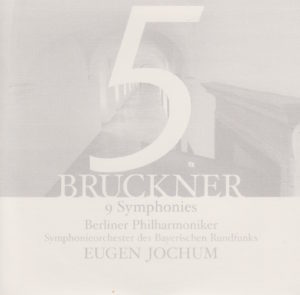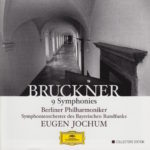 This morning’s conductor of Anton Bruckner’s Symphony No. 5 in B-Flat Major (WAB 105) – nicknamed “Tragic,” “Church of Faith,” or “Pizzicato” symphony (for reasons I’m still discovering), is German-born Eugen Jochum (1902-1987), unarguably one of the most highly respected interpreters of Anton Bruckner’s music who ever lived.
This morning’s conductor of Anton Bruckner’s Symphony No. 5 in B-Flat Major (WAB 105) – nicknamed “Tragic,” “Church of Faith,” or “Pizzicato” symphony (for reasons I’m still discovering), is German-born Eugen Jochum (1902-1987), unarguably one of the most highly respected interpreters of Anton Bruckner’s music who ever lived.
I have two CD box sets conducted by Jochum – this one, on the DG label, and one on the Warner Classics label. I chose to listen to the symphony from the DG set before the one from the Warner Classics label because the DG-label recording is older. (I figured alpha by conductor and then chronological was a fair enough delineator.)
 I first encountered Maestro Jochum in this box set (I call it the “white one”) on Day 6 of my 144-day project.
I first encountered Maestro Jochum in this box set (I call it the “white one”) on Day 6 of my 144-day project.
Then again on Day 22.
Then again on Day 38.
And, most recently, on Day 54.
Given what I heard from him many other times during the course of my project (this is, technically, the ninth time I’m listening to something conducted by Jochum), I’m expecting big stuff from Jochum in Bruckner’s Fifth.
First, just the facts, Ma’am:
Bruckner’s Symphony No. 5 in B-Flat Major (WAB 105) composed in 1875-1876
Eugen Jochum conducts
I have no idea which version Jochum chose; it’s not listed in the CD booklet/liner notes
Symphonieorchester des Bayerischen Rundfunks plays
The symphony clocks in at 76:52 (that’s getting really, really close to “Yikes!” territory)
This was recorded in Munich, Germany, in February of 1958
Jochum was 56 when he conducted it
Bruckner was 51 when he finished composing it
This recording was released on the Deutsche Grammophon (DG) abel
Bruckner wrote his symphonies in four parts. The time breakdown of this one (Symphony No. 5 in B Flat Major, probably the first version), from this particular conductor (Jochum) and this particular orchestra (Symphonieorchester des Bayerischen Rundfunks) is as follows:
I. Introduction (Adagio) — Allegro. B-flat major……………………………20:54
II. Adagio. Sehr langsam. (Very slowly) D minor……………………………19:23
III. Scherzo. Molto vivace D minor…………………………………………………12:35
IV. Finale (Adagio) — Allegro moderato. B-flat major…………………..24:00
Total running time: 76:52
From the liner notes by Constantin Floros,
A comparison could be made in the following terms, perhaps: where the Fourth Symphony is typified by its great radiance luxuriance, the Fifth, for all its colour, is significantly more austere and astringent…the contrapuntal brilliance of the Finale distinguishes the Fifth (which Bruckner himself is said to have called his “contrapuntal masterpiece”) from not only the Fourth but also all the other symphonies.
By the way, “contrapuntal” refers to counterpoint, a musical term that – according to its entry on Wikipedia – means,
In music, counterpoint is the relationship between voices that are harmonically interdependent (polyphony) yet independent in rhythm and contour. It has been most commonly identified in the European classical tradition, strongly developing during the Renaissance and in much of the common practice period, especially in the Baroque. The term originates from the Latin punctus contra punctum meaning “point against point”.
Okay. Now for the subjective stuff…
My Rating:
Recording quality: 3 (notable tape hiss, a somewhat flat recording, overly brassy horns)
Overall musicianship: 4
CD liner notes: 4 (two essays, one by Constantin Floros, one by Eugen Jochum, both translated into English, German, and French; would have been a “5” had the version they used been listed anywhere)
How does this make me feel: 3
Usually, I like older recordings. Haitink’s, for example. But this one seemed like a recording from the ’40s – compressed and flat. With the highs kind of piercing and the lows almost non existent.
It’s not a bad performance. Any fool could hear that. I can tell these people are fantastic musicians. Yet, I’m not getting the Wow Factor from this. Part of it is due to the sound of the recording.
Oh, I know!
It sounds like the audio track from an old TV show – kind of compressed and tinny. Not a broad stereo sound. More like a narrow mono sound.
Not dramatically so. And I’m not saying there’s anything wrong with this recording. My opinion is merely subjective. To my ears, this is not as deep or expansive as other recordings I’ve heard. Yesterday’s (Day 69), for example. Haitink’s performance was recorded in 1971. Granted, that’s nearly two decades later than this one from Jochum. But it’s 45 years ago from where we sit in 2016. So it’s still quite old.
Whereas Haitink’s performance from 1971 sounds vibrant and alive, Jochum’s performance from 1958 sounds much older and kind of static.
Anyway, I was disappointed with Jochum’s work on Bruckner’s Fifth. At least, in this recording. I will have another chance to hear Jochum (with another orchestra recorded in another year) tomorrow.
Maybe Bruckner’s “contrapuntal masterpiece” will become more evident to me on the morrow.
